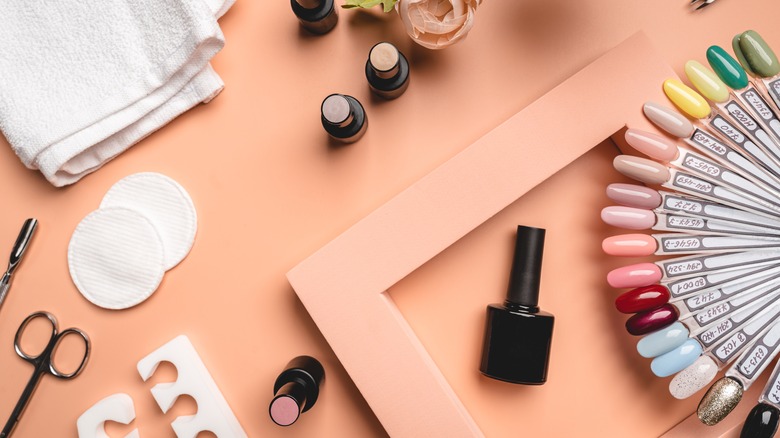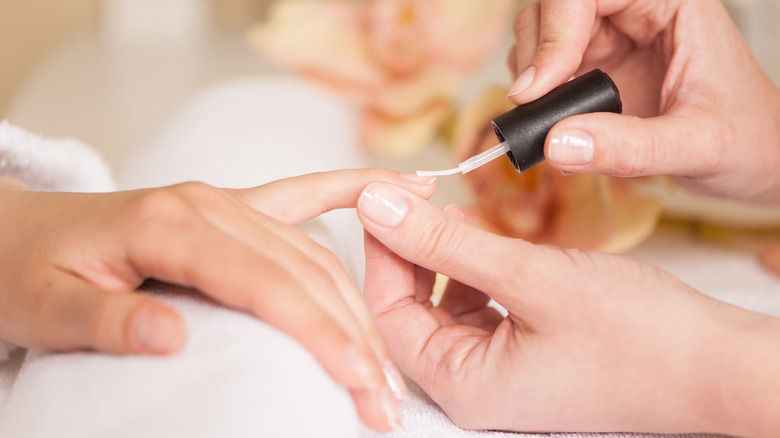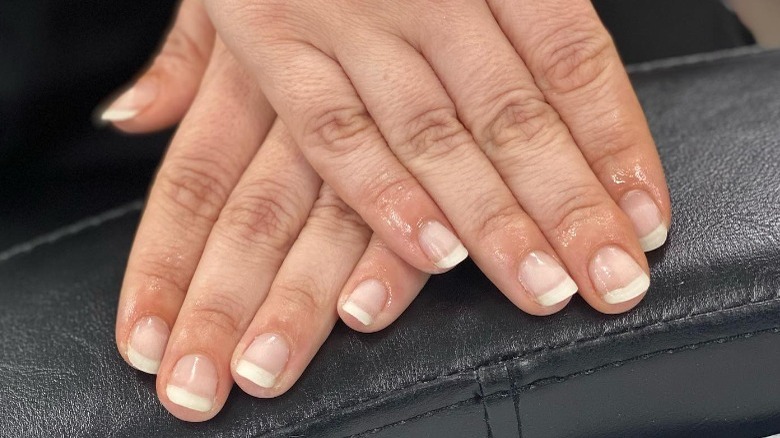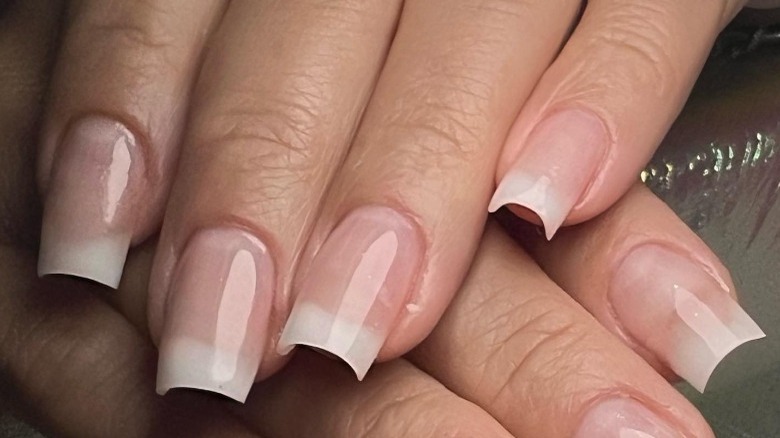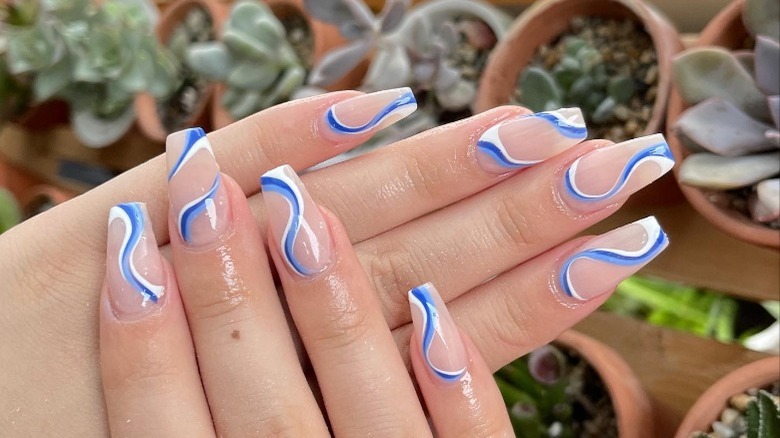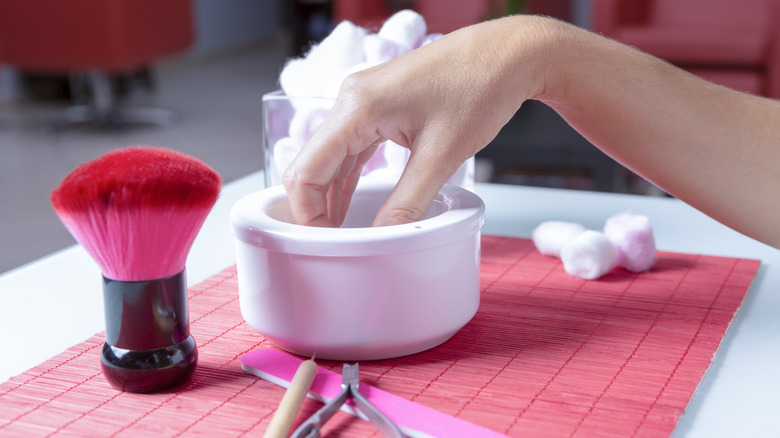Every Type Of Nail Wrap Explained
Nail designs are a fashion accessory in their own right. There are an array of styles with different colors and shapes. Whether they are a simple polish to match your outfit or a dramatic design with rhinestones, nail art is a means of self-expression. It can even make you look younger. Celebrity manicurist Deborah Lippmann tells New Beauty, "Clean and manicured nails — with or without polish — help hands look younger." If nail polish is your thing, Lippmann names orange as the go-to color for a youthful manicure, along with an oval shape for your nails.
But you know what they say, beauty is pain. Nail polishes and removers can cause yellowing, weakness, peeling, and soft nails, per Healthline. These effects are typically due to overexposure to chemicals that dehydrate your nail beds and cuticles. A manicure that is not harsh on your nails is the way to go, and nail wraps might just be the solution.
What are nail wraps?
When bulky acrylics and time-consuming dip nails aren't working for you, you might want to consider nail wraps. Although it is having a newfound burst of popularity lately, this manicure technique actually isn't new. In fact, Nails shares that it was developed in the 1980s, the era of leg warmers and shoulder pads. However, this style of manicure is coming back into the mainstream because of its versatility. Unlike gel polish and SNS nails, wraps can help grow out your nails and offer a natural look.
Via Nailpro, owner of LimeLight Nail Designs and international nail competition judge Anita Lime-Sims says, "The advantage of wraps is that they're virtually undetectable under polish or gel, which is great since they soak off easily." But there are a few different kinds of nail wraps. Each type of fabric wrap comes with its own perks, so which one is right for you?
Silk nail wraps
When we think of silk, the light, breezy fabric comes to mind, but you can use that same material to create a killer manicure. Beauty Answered explains that with this nail style, pieces of silk are adhered with glue and filed to shape your nails. You can coat your silk-wrapped nails with polish or leave them bare for the optimal simple design. Not only are these wraps great for manicures, but also for nail repair, as a silk wrap is an easy trick for fixing a broken nail. Applying the wrap to chipped nails allows them to grow without having to clip them right away.
Silk nails are ideal for their natural look, as they are thinner than acrylics and press-ons. However, its thinness does not make it suitable for anyone who uses their hands often. They are fragile, and Foundation Fairy warns that constant hand washing can damage or deteriorate silk nails. Silk nails are not the best wrap option if you work with your hands, but luckily, there are more options.
Nail wraps using fiberglass
Fiberglass has made its way into the beauty industry. A fiberglass manicure might sound wild, but it works. Square Hue explains that the fibers are placed onto your nail beds and attached with resin glue. After the glue dries, the wrap is shaped via a nail file or drill. You can use a fiberglass wrap to strengthen and extend the length of your nails, or to add extra durability to acrylic nails. Unfortunately, this manicure style only lasts a few weeks, and continuous exposure to water can shorten its lifespan. However, they are kinder on your nails than other artificial styles.
Manicurist Lauren LaRouge tells MamaMia, "Fiberglass is actually meant to be less damaging to the natural nails than other methods such as SNS or acrylics." This makes fiberglass nails a great acrylic nail alternative and suitable for those wanting to grow their natural nails. Fiberglass designs are also thin, creating a natural look that is harder-wearing than silk wraps. The process for this application is complicated and requires several fibers for each nail, so it's best left to the professionals.
Linen nail wraps
Another great option is linen wraps, as this woven fabric can repair a broken nail or be the base for a stunning manicure. According to Nails, linen wraps use a special bonder to adhere the cloth to your fingernails. Unlike fiberglass wraps, linen nails don't give you any added length, so you'll have to add tips to your wrap service for longer nails. Your linen manicure can last up to six weeks with the proper application and maintenance.
When it comes to strength, linen surpasses fiberglass and silk nails, per Milady's Cosmetology Standard Textbook. It is thicker than other wraps, often lending to a chunkier nail design. The woven linen will also be visible after the adhesive is placed on your nails, so it is not the best option for a natural look. A color polish is needed unless you want a gauze-like design. When you're ready to move on to a new trendy nail style, it only takes a few steps to remove the fabric wraps.
How to remove nail wraps
Nail wraps are quite easy to remove. Once the bonding coat wears, the fabric wrap will peel away from your nail beds. Manicurist Lauren LaRouge says that these wraps "should be removed the same way as acrylics — by soaking in acetone," (via MamaMia). Let your fingernails relax in an acetone pool for a few minutes before wiping away any excess wrap with a cotton ball. If fabric or glue still coats your nail, repeat the soaking process.
Acetone can be harsh on the skin though. Sinclair Dermatology warns acetone can dry out your fingertips, leading to brittle nails and peeling cuticles. Despite the dehydration, acetone is still the most effective way to remove nail wraps, polishes, and tips. To combat your nails drying out, moisturize your nails after the acetone soaks (and don't forget about your cuticles, massaging in cuticle oil can go a long way for your nail health). Ultimately, the base for any perfect manicure is healthy nails.
